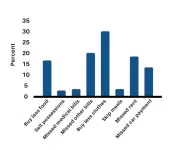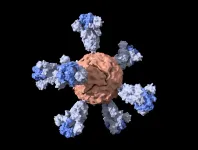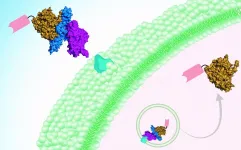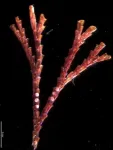INFORMATION:
This research was supported, in part, by MIT Sea Grant, the Simons Foundation, the MIT Montrym, Ferry, and mTerra funds, and by Bruce Heflinger '69, SM '71, PhD '80.
Written by Jennifer Chu, MIT News Office
Additional background
Paper: "Discovery and quantification of anaerobic nitrogen metabolisms among oxygenated tropical Cuban stony corals"
https://www.nature.com/articles/s41396-020-00845-2
Scientists discover slimy microbes that may help keep coral reefs healthy
The bacteria scrub out nitrogen, potentially defending against certain nutrient overloads
2021-01-08
(Press-News.org) Corals have evolved over millennia to live, and even thrive, in waters with few nutrients. In healthy reefs, the water is often exceptionally clear, mainly because corals have found ways to make optimal use of the few resources around them. Any change to these conditions can throw a coral's health off balance.
Now, researchers at MIT and the Woods Hole Oceanographic Institution (WHOI), in collaboration with oceanographers and marine biologists in Cuba, have identified microbes living within the slimy biofilms of some coral species that may help protect the coral against certain nutrient imbalances.
The team found these microbes can take up and "scrub out" nitrogen from a coral's surroundings. At low concentrations, nitrogen can be an essential nutrient for corals, providing energy for them to grow. But an overabundance of nitrogen, for instance from the leaching of nitrogen-rich fertilizers into the ocean, can trigger mats of algae to bloom. The algae can outcompete coral for resources, leaving the reefs stressed and bleached of color.
By taking up excess nitrogen, the newly identified microbes may prevent algal competition, thereby serving as tiny protectors of the coral they inhabit. While corals around the world are experiencing widespread stress and bleaching from global warming, it seems that some species have found ways to protect themselves from other, nitrogen-related sources of stress.
"One of the aspects of finding these organisms in association with corals is, there's a natural way that corals are able to combat anthropogenic influence, at least in terms of nitrogen availability, and that's a very good thing," says Andrew Babbin, the Doherty Assistant Professor in Ocean Utilization in MIT's Department of Earth, Atmospheric and Planetary Sciences. "This could be a very natural way that reefs can protect themselves, at least to some extent."
Babbin and his colleagues have reported their findings in the the ISME Journal.
Dead zone analogues
Babbin's group studies how marine communities in the ocean cycle nitrogen, a key element for life. Nitrogen in the ocean can take various forms, such as ammonia, nitrite, and nitrate. Babbin has been especially interested in studying how nitrogen cycles, or is taken up, in anoxic environments -- low-oxygen regions of the ocean, also known as "dead zones," where fish are rarely found and microbial life can thrive.
"Locations without enough oxygen for fish are where bacteria start doing something different, which is exciting to us," Babbin says. "For instance, they can start to consume nitrate, which has then an impact on how productive a specific part of the water can be."
Dead zones are not the only anoxic regions of the ocean where bacteria exhibit nitrogen-feasting behavior. Low-oxygen environments can be found at smaller scales, such as within biofilms, the microbe-rich slime that covers marine surfaces from shipwrecked hulls to coral reefs.
"We have biofilms inside us that allow different anaerobic processes to happen," Babbin notes. "The same is true of corals, which can generate a ton of mucus, which acts as this retardation barrier for oxygen."
Despite the fact that corals are close to the surface and within reach of oxygen, Babbin wondered whether coral slime would serve to promote "anoxic pockets," or concentrated regions of low oxygen, where nitrate-consuming bacteria might thrive.
He broached the idea to WHOI marine microbiologist Amy Apprill, and in 2017, the researchers set off with a science team on a cruise to Cuba, where Apprill had planned a study of corals in the protected national park, Jardines de la Reina, or Gardens of the Queen.
"This protected area is one of the last refuges for healthy Caribbean corals," Babbin says. "Our hope was to study one of these less impacted areas to get a baseline for what kind of nitrogen cycle dynamics are associated with the corals themselves, which would allow us to understand what an anthropogenic perturbation would do to that system."
Swabbing for scrubbers
In exploring the reefs, the scientists took small samples from coral species that were abundant in the area. Onboard the ship, they incubated each coral specimen in its own seawater, along with a tracer of nitrogen -- a slightly heavier version of the molecules found naturally in seawater.
They brought the samples back to Cambridge and analyzed them with a mass spectrometer to measure how the balance of nitrogen molecules changed over time. Depending on the type of molecule that was consumed or produced in the sample, the researchers could estimate the rate at which nitrogen was reduced and essentially denitrified, or increased through other metabolic processes.
In almost every coral sample, they observed rates of denitrification were higher than most other processes; something on the coral itself was likely taking up the molecule.
The researchers swabbed the surface of each coral and grew the slimy specimens on Petri dishes, which they examined for specific bacteria that are known to metabolize nitrogen. This analysis revealed multiple nitrogen-scrubbing bacteria, which lived in most coral samples.
"Our results would imply that these organisms, living in association with the corals, have a way to clean up the very local environment," Babbin says. "There are some coral species, like this brain coral Diploria, that exhibit extremely rapid nitrogen cycling and happen to be quite hardy, even through an anthropogenic change, whereas Acropora, which is in rough shape throughout the Caribbean, exhibits very little nitrogen cycling. "
Whether nitrogen-scrubbing microbes directly contribute to a coral's health is still unclear. The team's results are the first evidence of such a connection. Going forward, Babbin plans to explore other parts of the ocean, such as the tropical Pacific, to see whether similar microbes exist on other corals, and to what extent the bacteria help to preserve their hosts. His guess is that their role is similar to the microbes in our own systems.
"The more we look at the human microbiome, the more we realize the organisms that are living in association with us do drive our health," Babbin says. "The exact same thing is true of coral reefs. It's the coral microbiome that defines the health of the coral system. And what we're trying to do is reveal just what metabolisms are part of this microbial network within the coral system."
ELSE PRESS RELEASES FROM THIS DATE:
Latina mothers, often essential workers, report COVID-19 took toll
2021-01-08
More than half of Latina mothers surveyed in Yolo and Sacramento counties reported making economic cutbacks in response to the pandemic shutdown last spring -- saying they bought less food and missed rent payments. Even for mothers who reported receiving the federal stimulus payment during this time, these hardships were not reduced, University of California, Davis, researchers found in a recent study.
"Latino families are fighting the pandemic on multiple fronts, as systemic oppression has increased their likelihood of contracting the virus, having complications from the virus and having significant economic hardship due to the virus," said Leah C. Hibel, associate professor of human development and family studies at UC Davis and ...
Novel RNA factors may help cancer cells thrive
2021-01-08
Like Peter Pan, some cells never grow up. In cancer, undifferentiated stem cells may help tumors such as glioblastoma become more aggressive than other forms of the disease. Certain groups of genes are supposed to help cells along the path to maturity, leaving their youthful "stemness" behind. This requires sweeping changes in the microRNAome -- the world of small non-coding material, known as microRNAs, that control where and when genes are turned on and off. Many microRNAs are tumor-suppressive; in cancer, the microRNAome is distorted and disrupted. Recent work by researchers at Brigham and Women's Hospital pinpoints critical changes in an enzyme known as DICER, which create a cascade of effects on this microRNAome. ...
Peter Raven addresses earth's dwindling resources, the value of science-informed outreach
2021-01-08
The BioScience Talks podcast features discussions of topical issues related to the biological sciences.
In a career-spanning installment of the journal BioScience's In Their Own Words oral history series, Missouri Botanical Garden President Emeritus Peter Raven illuminates numerous topics, sharing insights related to the sustainability of human civilization, the COVID-19 pandemic, and the importance of science in addressing the world's greatest challenges.
Raven, a recent coauthor of "A Call to Action: Marshaling Science for Society," highlights the importance of public outreach in overcoming deeply rooted societal problems. Among them, he argues that our present economic system "sees natural productivity like every other ...
Nanoparticle vaccine for COVID-19
2021-01-08
Before the pandemic, the lab of Stanford University biochemist Peter S. Kim focused on developing vaccines for HIV, Ebola and pandemic influenza. But, within days of closing their campus lab space as part of COVID-19 precautions, they turned their attention to a vaccine for SARS-CoV-2, the virus that causes COVID-19. Although the coronavirus was outside the lab's specific area of expertise, they and their collaborators have managed to construct and test a promising vaccine candidate.
"Our goal is to make a single-shot vaccine that does not require a cold-chain for storage or transport. If we're successful at doing it ...
Botulism breakthrough? Taming botulinum toxin to deliver therapeutics
2021-01-08
While rare, botulism can cause paralysis and is potentially fatal. It is caused by nerve-damaging toxins produced by Clostridium botulinum -- the most potent toxins known. These toxins are often found in contaminated food (home canning being a major culprit). Infants can also develop botulism from ingesting C. botulinum spores in honey, soil, or dust; the bacterium then colonizes their intestines and produces the toxin.
Once paralysis develops, there is no way to reverse it, other than waiting for the toxins to wear off. People with serious cases of botulism may need to be maintained on ventilators for weeks or months. But a new treatment approach and delivery vehicle, ...
More than half of people using cannabis for pain experience multiple withdrawal symptoms
2021-01-08
More than half of people who use medical marijuana products to ease pain also experience clusters of multiple withdrawal symptoms when they're between uses, a new study finds.
And about 10% of the patients taking part in the study experienced worsening changes to their sleep, mood, mental state, energy and appetite over the next two years as they continued to use cannabis.
Many of them may not recognize that these symptoms come not from their underlying condition, but from their brain and body's reaction to the absence of substances in the cannabis products they're smoking, vaping, eating or applying to their skin, says the University of Michigan Addiction Center psychologist who led the study.
When someone ...
Tiny wireless device sheds light on combating obesity
2021-01-08
Gastric bypass surgery is sometimes the last resort for those who struggle with obesity or have serious health-related issues due to their weight. Since this procedure involves making a small stomach pouch and rerouting the digestive tract, it is very invasive and prolongs the recovery period for patients. In a new study, researchers at Texas A&M University have described a medical device that might help with weight loss and requires a simpler operative procedure for implantation.
Researchers said their centimeter-sized device provides the feeling of fullness by stimulating the endings of the vagus nerve with light. Unlike other devices that require a power cord, their device is wireless and can be controlled ...
Study reveals jellyfish create a 'virtual wall' to enhance performance
2021-01-08
TAMPA, Fla. (Jan. 8, 2021)- New research led by the University of South Florida has uncovered one of the reasons jellyfish have come to be known as the "world's most efficient swimmer." Brad Gemmell, associate professor of integrative biology, found jellyfish produce two vortex rings, which are donut-shaped bodies of fluid underneath their translucent bodies, that spin in opposite directions. They appear as jellyfish squeeze and reopen throughout each swim cycle, providing a "ground effect" force as if they were to be pushing off the seafloor.
The "ground effect" is most widely understood ...
Scientists from St. Petersburg University discovered the virus-like particles in Bryozoa
2021-01-08
Scientists from Russia, Austria, and the USA have discovered virus-like particles in the bacterial symbionts of Bryozoa - a phylum of colonial aquatic invertebrates - filter-feeders dominating in many bottom ecosystems. The research project was planned and supervised by scientists from St Petersburg University. Some of the virus-like particles resemble red blood cells, while others have a sea-urchin-like appearance. Although viruses have never been reported inside symbiotic bacteria in bryozoans, scientists suggest that this "matryoshka doll" may have a prominent effect on the bacterial ...
Measuring racial inequities in COVID-19 testing
2021-01-08
What The Study Did: This study adapted a well-established tool for measuring inequity from economics--the Lorenz curve--to measure racial inequities in COVID-19 testing.
Author: Aaloke Mody, M.D., of the Washington University School of Medicine in St Louis, is the corresponding author.
To access the embargoed study: Visit our For The Media website at this link https://media.jamanetwork.com/
(doi:10.1001/jamanetworkopen.2020.32696)
Editor's Note: The article includes funding/support disclosures. Please see the article for additional information, including other authors, author contributions and affiliations, conflict of interest and financial disclosures, and funding and support.
INFORMATION:
Media ...
LAST 30 PRESS RELEASES:
Why nail-biting, procrastination and other self-sabotaging behaviors are rooted in survival instincts
Regional variations in mechanical properties of porcine leptomeninges
Artificial empathy in therapy and healthcare: advancements in interpersonal interaction technologies
Why some brains switch gears more efficiently than others
UVA’s Jundong Li wins ICDM’S 2025 Tao Li Award for data mining, machine learning
UVA’s low-power, high-performance computer power player Mircea Stan earns National Academy of Inventors fellowship
Not playing by the rules: USU researcher explores filamentous algae dynamics in rivers
Do our body clocks influence our risk of dementia?
Anthropologists offer new evidence of bipedalism in long-debated fossil discovery
Safer receipt paper from wood
Dosage-sensitive genes suggest no whole-genome duplications in ancestral angiosperm
First ancient human herpesvirus genomes document their deep history with humans
Why Some Bacteria Survive Antibiotics and How to Stop Them - New study reveals that bacteria can survive antibiotic treatment through two fundamentally different “shutdown modes”
UCLA study links scar healing to dangerous placenta condition
CHANGE-seq-BE finds off-target changes in the genome from base editors
The Journal of Nuclear Medicine Ahead-of-Print Tip Sheet: January 2, 2026
Delayed or absent first dose of measles, mumps, and rubella vaccination
Trends in US preterm birth rates by household income and race and ethnicity
Study identifies potential biomarker linked to progression and brain inflammation in multiple sclerosis
Many mothers in Norway do not show up for postnatal check-ups
Researchers want to find out why quick clay is so unstable
Superradiant spins show teamwork at the quantum scale
Cleveland Clinic Research links tumor bacteria to immunotherapy resistance in head and neck cancer
First Editorial of 2026: Resisting AI slop
Joint ground- and space-based observations reveal Saturn-mass rogue planet
Inheritable genetic variant offers protection against blood cancer risk and progression
Pigs settled Pacific islands alongside early human voyagers
A Coral reef’s daily pulse reshapes microbes in surrounding waters
EAST Tokamak experiments exceed plasma density limit, offering new approach to fusion ignition
Groundbreaking discovery reveals Africa’s oldest cremation pyre and complex ritual practices
[Press-News.org] Scientists discover slimy microbes that may help keep coral reefs healthyThe bacteria scrub out nitrogen, potentially defending against certain nutrient overloads





